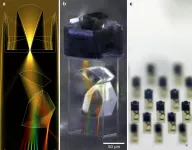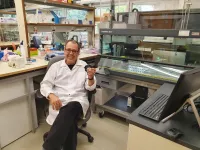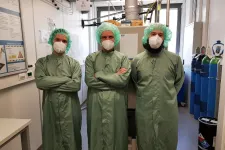Researchers produce tiny nanoparticles and reveal their inner structure for the first time
2021-02-08
(Press-News.org) Tiny nanoparticles can be furnished with dyes and could be used for new imaging techniques, as chemists and physicists at Martin Luther University Halle-Wittenberg (MLU) show in a recent study. The researchers have also been the first to fully determine the particles' internal structure. Their results were published in the renowned journal Angewandte Chemie.
Single-chain nanoparticles (SCNPs) are an attractive material for chemical and biomedical applications. They are created from just a single chain of molecules that folds into a particle whose circumference measures three to five nanometres. "Because they are so small, they can travel everywhere in the human body and be used for a wide variety of purposes," says Professor Wolfgang Binder from the Institute of Chemistry at MLU. As it is a new area of research, some questions still remain unanswered. Up until now, for example, the inner structure of the particles had only been assumed, but not finally resolved.
After Binder and his team developed new single-chain nanoparticles that could be used in medicine, they wanted to know more about their structure. "We concluded that the nanoparticles we developed must have a special, internal structure," says Binder. To establish this, he contacted colleagues from the departments of chemistry and physics at MLU. Using a combination of electron spin resonance and fluorescence spectroscopy, the scientists were able to visualise the structure of an SCNP for the first time. "They form a kind of nano-pocket that can protect a dye or other molecules," explains Binder. Their findings are in line with previous assumptions about the possible spatial structure within such tiny particles.
The aim of Binder's research group is to develop nanoparticles for diagnostic testing. However, producing the nanoparticles is a complex task. "They have to be virtually invisible to the body," explains Justus Friedrich Hoffmann, a PhD student in Binder's research group. They cannot be destroyed by the body's immune system and they must also have the right internal binding sites so that a dye or another molecule can be stored and protected. In addition, they have to be water-soluble so that they can be transported via the bloodstream. "They often form large clumps, but we have now been able to produce individual particles," says Hoffmann. They used a chemical trick to condense the chain into the desired form.
The dye, which is incorporated during the manufacturing process, is to be used for so-called photoacoustic imaging. The procedure represents an alternative to computer tomography but without the dangerous radiation. It allows one to look several centimetres deep into tissue from outside the body. Normally the dye is quickly destroyed by the body, says Binder. The tiny nanoparticles protect the dye, which could be used, for example, in the visualisation of tumours which it would enter via blood vessels.
SCNPs can be used in a wide variety of other applications, too. For instance, they could be used as nanoreactors in which chemical reactions take place.
INFORMATION:
The research was funded by the Deutsche Forschungsgemeinschaft (DFG, German Research Foundation).
ELSE PRESS RELEASES FROM THIS DATE:
2021-02-08
In humans, differences in personalities have been evident since the ancient times. Personality in animals has long been ignored, but recently this question has received increasing research interest as it has been realized that personality has evolutionary and ecological significance. An international team of behavioral biologists from Austria, Brazil and the Netherlands, with Vedrana Å lipogor from the University of Vienna as leading author of the study, designed a set of tasks to assess personality of common marmosets. These results have just been published in American Journal of Primatology.
Marmosets are small highly social New World monkeys that parallel humans in their social organization, as they live in cohesive ...
2021-02-08
Researchers from the Institute of Environmental Science and Technology of the Universitat Autònoma de Barcelona (ICTA-UAB) warn of the impact the current tourism model in the Mediterranean islands has on the production of marine litter on beaches, and recommend taking advantage of the situation generated by the Covid19 pandemic to rethink a new more sustainable model. The research, recently published in the journal Scientific Reports, shows that the recreational use of Mediterranean island beaches during the summer is responsible for up to 80% of the marine litter accumulating on those beaches, and generates huge amounts of microplastics through the fragmentation ...
2021-02-08
A German-Chinese research team has found a new synthetic route to produce biofuel from biomass. The chemists converted the substance 5-hydroxymethylfurfural (HMF) produced from biomass into 2,5-dimethylfuran (DMF), which could be suitable as a biofuel. Compared to previous methods, they achieved a higher yield and selectivity under milder reaction conditions. The team led by Dr. Baoxiang Peng and Professor Martin Muhler from the Laboratory of Industrial Chemistry at Ruhr-Universität Bochum (RUB) and the group led by Professor Christof Hättig from the RUB Chair for Theoretical Chemistry described the method together with colleagues from Changzhou, ...
2021-02-08
Solar energy is one of the most abundant renewable energy sources, and effective solar technologies have great potential to alleviate the grand challenges of rising global energy demands, while reducing associated emissions. Solar energy is capable of satisfying the electrical and thermal-energy needs of diverse end-users by means of photovoltaic (PV) and solar thermal (ST) technologies, respectively. Recently, hybrid photovoltaic-thermal (PVT) concepts have been proposed that synergistically combine the benefits of PV and ST technologies, and are capable of generating both electricity and useful heat simultaneously from the same area and component.
Spectral splitting is an emerging approach for designing high-performance PVT solar collectors, which employ advanced designs ...
2021-02-08
The molecular details of how SARS-CoV-2 enters cells and infects them are still not clear. Researchers at Uppsala University have tested the bioinformatic predictions made by another research group and have identified receptors that could be important players in the process. The results are presented in the journal Science Signaling and at the AAAS Annual Meeting held this week.
The spike protein of SARS-CoV-2 binds the protein ACE2 on the outside of the human cell. This triggers a series of events that leads to invasion of the cell by the virus. The molecular details of this process have remained obscure ...
2021-02-08
Femtosecond direct laser writing as a 3D printing technology has been one of the key building blocks for miniaturization in modern times. It has transformed the field of complex microoptics since the early 2000s. Especially medical engineering and consumer electronics as vastly growing fields benefit from these developments. It is now possible to create robust, monolithic and nearly perfectly aligned freeform optical systems on almost arbitrary substrates such as image sensors or optical fibers.
Simultaneously, the miniaturisation of spectroscopic measurement devices has been advanced, for instance based on quantum dot or nanowire technology. These are based on computational approaches, which have the drawback of ...
2021-02-08
For decades, the speed of our computers has been growing at a steady pace. The processor of the first IBM PC released 40 years ago, operated at a rate of roughly 5 million clock cycles per second (4.77 MHz). Today, the processors in our personal computers run around 1000 times faster.
However, with current technology, they're not likely to get any faster than that.
For the last 15 years, the clock rate of single processor cores has stalled at a few Gigahertz (1 Gigahertz = 1 billion clock cycles per second). And the old and tested approach of cramming ...
2021-02-08
In diagnostic medicine, biopsies, where a sample of tissue is extracted for analysis, is a common tool for the detection of many conditions. But this approach has several drawbacks - it can be painful, doesn't always extract the diseased tissue, and can only be used in a sufficiently advanced disease stage, making it, in some cases, too late for intervention. These concerns have encouraged researchers to find less invasive and more accurate options for diagnoses.
Professor Nir Friedman and Dr. Ronen Sadeh of the Life Sciences Institute and School of Computer Engineering have published a study in Nature Biotechnology that shows how a wide range of diseases can be detected through a simple ...
2021-02-08
In certain materials, electrical and mechanical effects are closely linked: for example, the material may change its shape when an electrical field is applied or, conversely, an electrical field may be created when the material is deformed. Such electromechanically active materials are very important for many technical applications.
Usually, such materials are special, inorganic crystals, which are hard and brittle. For this reason, so-called ferroelectric polymers are now being used. They are characterised by the fact that their polymer chains exist simultaneously in two different microstructures: some areas are strongly ...
2021-02-08
A study has described genetic changes in patients with the most common form of hereditary kidney disease that affects an estimated 12.5 million people worldwide. The research, which focussed on Polycystic Kidney Disease (PKD) in Ireland, provides insights into PKD that will assist doctors and patients in the management of this of inherited condition.
The study, led by researchers from the RCSI University of Medicine and Health Sciences, is published in the European Journal of Human Genetics.
In the research, a cohort of 169 patients with PKD in Ireland were analysed. The genetic changes were identified in up ...
LAST 30 PRESS RELEASES:
[Press-News.org] Researchers produce tiny nanoparticles and reveal their inner structure for the first time





